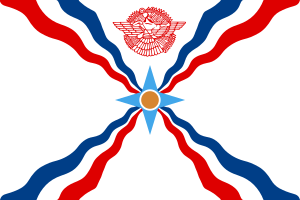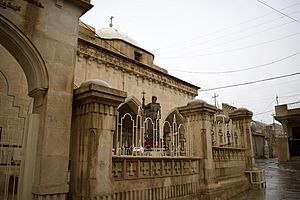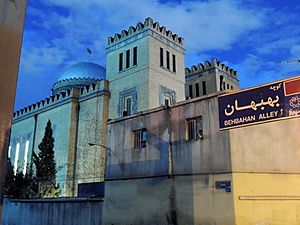Chaldean Catholics facts for kids
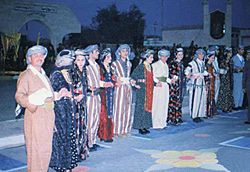
Chaldean Catholics from Alqosh, 1980s
|
|
| Total population | |
|---|---|
| 616,639 (2018) | |
| Regions with significant populations | |
| Assyrian homeland | 300,000+ |
| 241,471 (2016) | |
| 48,594 (2016) | |
| 10,000 (2016) | |
| 3,390 (2016) | |
| Assyrian diaspora | 300,000+ |
| 250,000 (2018) | |
| 31,372 (2016) | |
| 17,172 (2016) | |
| Religions | |
| Chaldean Catholic Church | |
| Scriptures | |
| The Bible (Pshitta) | |
| Languages | |
| Neo-Aramaic (Sureth), Mesopotamian Arabic | |
Chaldean Catholics are a group of Christian people. They are also known as Chaldeans or Assyro-Chaldeans. These people are part of the Assyrian people and follow the Chaldean Catholic Church. This church comes from the older Church of the East.
Other Christian groups among Assyrian people include the Assyrian Church of the East and the Ancient Church of the East. There are also the Syriac Orthodox Church and the Syriac Catholic Church.
The Chaldean Catholic community started in a region called Upper Mesopotamia in the 1500s and 1600s. They were groups from the Church of the East who joined the Holy See (the Catholic Church). Chaldean Catholics originally lived in northern Mesopotamia. This area is now part of Iraq, Turkey, and Syria. Many have since moved to Western countries like the United States, Canada, and Australia. Chaldean Catholics also live in Lebanon, Iran, and other countries. They have moved due to things like religious persecution and poor living conditions.
Contents
What's in a Name?
Followers of the Chaldean Catholic Church are often called "Chaldean". They also call themselves Suraye in their own language. When their community joined the Catholic Church, they were called Chaldeans. This name was used to tell them apart from other groups.
In 1908, before big changes in the Middle East, an article said that the name "Chaldean" was not exactly right. Most Chaldean people were found in cities like Kirkuk and Mosul. These areas were in the heart of Assyria. The local people sometimes called themselves Atoraya-Kaldaya (Assyro-Chaldeans).
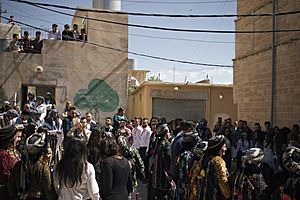
Some Kurdish groups sometimes incorrectly call local Christians "Kurdish Christians". Some Assyrians in northern Iraq supported Kurdish groups. They wanted to promote Assyrian nationalism. They also wanted to use "Assyrian" as a name for all Christians. This was to show a link to the ancient Assyrian people. The Assyrian Democratic Movement suggested the name "Chaldo-Assyrian". However, the Chaldean Catholic Church later stopped supporting this name.
Raphael I Bidawid, a leader of the Chaldean Catholic Church, spoke about these names. He said that the original name of their Church was the 'Church of the East'. When part of the Church became Catholic, they were called 'Chaldean'. He believed this name came from the Magi kings. He also said that 'Chaldean' is a church name, not an ethnic name. He stated, "I myself, my sect is Chaldean, but ethnically, I am Assyrian."
In 2017, the Chaldean Catholic Church made an official statement. They said they value their unique Chaldean identity. This identity is recognized in the Constitution of Iraq. They asked their people to stick to their Chaldean identity. They also asked them to respect other names like 'Assyrians' and 'Syriacs'.
An old letter from 1838 said that the "Chaldeans" of Mesopotamia got their title from the pope. This happened when they became Catholics. In 1843, a review stated that the Pope gave them the title "Chaldeans".
In 1881, the archaeologist Hormuzd Rassam said that people in Assyria were mixed. He mentioned Arabs, Turkomans, Kurds, Yazidis, Jews, and Christians. He noted that Christians called Chaldeans and Syrians likely belonged to one group, the Assyrian people. They were given different names due to religious disagreements.
Where Do Chaldean Catholics Live?
There were about 640,828 Chaldean Catholics around the world in 2016.
In Iraq
About 250,000 Christians live in Iraq today. Most of them (80%) are Chaldean Catholics. In northern Iraq, Chaldean Catholics live in towns like Alqosh and Ankawa. The main church for Chaldean Catholics is in Baghdad. It is called the Cathedral of Our Lady of Sorrows. This is also where their leader, Patriarch Louis Raphaël I Sako, lives.
The Iraqi constitution mentions Chaldeans in Article 125. It says they are a nationality, different from others. The constitution promises to protect their rights.
In Other Countries
In Syria, there are about 10,000 Chaldean Catholics. In Turkey, there are 48,594. In Iran, there are 3,390.
Around the World (Diaspora)
A large Chaldean Catholic community lives in Southeast Michigan in the United States. It has over 113,000 people. This is the biggest Chaldean Catholic community outside Iraq. Most of them speak Neo-Aramaic or Arabic. A small number of Chaldean Catholic families also live in Israel and the Palestinian territories.
A Look at Their History
The Chaldean community started from groups of the Church of the East. They joined the Roman Catholic Church in the 1500s and 1600s. This happened after a split in the church in 1552. The Catholic Church gave these groups the name "Chaldeans".
The term "Chaldean" for these Christians began in the mid-1400s. Before that, it referred to the Church of the East. This church was sometimes called "Nestorian" because it did not accept a certain church council.
The name "Chaldean" did not mean they were from ancient Chaldea. Instead, it referred to their use of the Syriac language. This language is a form of Aramaic. Chaldean Catholics come from old communities in northern Iraq and Mesopotamia. This area was once known as Assyria. Chaldean Catholics share family names and genetic profiles with their neighbors. They also come from the same villages and towns. Their languages, like Chaldean Neo-Aramaic, are not tied only to their religion.
The term "Chaldean" was used for all people of the Church of the East tradition. This was true whether they were part of the Catholic Church or not. This continued into the 1900s.
In the 1900s
A 1950 report said there were 98,000 Chaldean Catholics in Iraq. They were the largest Christian minority. The report also estimated 30,000 Nestorians and 25,000 Syriac Catholics.
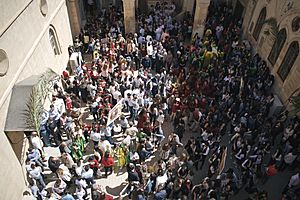
In Recent Times
In 2019, a report said that about 80% of Iraqi Christians were Chaldean Catholics. Another report in 2018 said it was about 67%. Around 45% of the Assyrian people belong to the Chaldean Catholic Church.
In 2008, there were about 550,000 Catholics in Iraq. They were the majority of Iraq's Christians. But many Iraqi Christians faced danger after the 2003 war. About 60,000 Christians had left the country by then. A well-known Iraqi Chaldean Catholic was Tariq Aziz. He was a Deputy Prime Minister.
By 2012, hundreds of thousands of Christians left Iraq. This happened after Saddam Hussein was removed from power. Many went to Europe and the United States. In 2008, the Chaldean Catholic Archbishop of Mosul, Paulos Faraj Rahho, was kidnapped and found dead. Pope Benedict XVI and other leaders spoke out against his death.
About the Chaldean Catholic Church
In 1896, a count of Chaldean Catholics showed 233 parishes and 177 churches. Most were in northern Iraq and southeastern Turkey. There were 248 priests. Monks from the Rabban Hormizd Monastery also helped. There were about 52 Chaldean schools.
The total number of Chaldean Christians in 2010 was 490,371. About 78,000 of them were in the Diocese of Mosul.
The current patriarch (leader) considers Baghdad the main city for his church. His title used to be "Patriarch of Babylon". This was because Baghdad was linked to ancient Babylon. However, the patriarch usually lives in Mosul in the north.
There are five archbishops and seven bishops. Eight special leaders help manage smaller Chaldean communities. These are spread across Turkey and Iran. The Chaldean clergy have also set up missions in mountain areas.
The language used in Chaldean Catholic Church services is Syriac. The church's writings are in the Syriac alphabet. A person named Paul Bedjan helped bring back interest in old Chaldean writings. He was an Assyrian Chaldean Catholic.
Groups and Leaders
Chaldean Catholics have different groups and leaders. Some are political parties, and some are militias.
- Parties
- Chaldean Democratic Party: A democratic party in Iraq.
- Chaldean Syriac Assyrian Popular Council: A joint democratic party in Iraq.
- Assyrian Democratic Movement: An Assyrian political party in Iraq.
- Sons of Mesopotamia: An Assyrian political party in Iraq.
- Militias
- Qaraqosh Protection Committee
- Nineveh Plain Protection Units
- Babylon Movement
- Dwekh Nawsha
Famous Chaldean Catholics
- Mark Arabo – A Chaldean-American who speaks for Christians in Iraq.
- Tariq Aziz – A former Deputy Prime Minister and Foreign Minister of Iraq.
- Issa Benyamin – A skilled calligrapher.
- Paul Bedjan – A writer who helped revive old Chaldean writings.
- Toma Audo – A bishop and writer.
- Hormuzd Rassam – An archaeologist from the Middle East.
- Maria Theresa Asmar
- Anna Eshoo
- Hala Y. Jarbou
- Rebin Sulaka – A Chaldean Swedish footballer who plays for Iraq.
- Justin Meram
- Randa Markos
- Mona Hanna-Attisha
- Basim Bello – The Mayor of Tel Keppe, Iraq.
See also
 In Spanish: Cristianos caldeos para niños
In Spanish: Cristianos caldeos para niños
- Assyrian Church of the East
- Ancient Church of the East
- Syriac Christianity
- Terms for Syriac Christians
- East Syriac Rite


